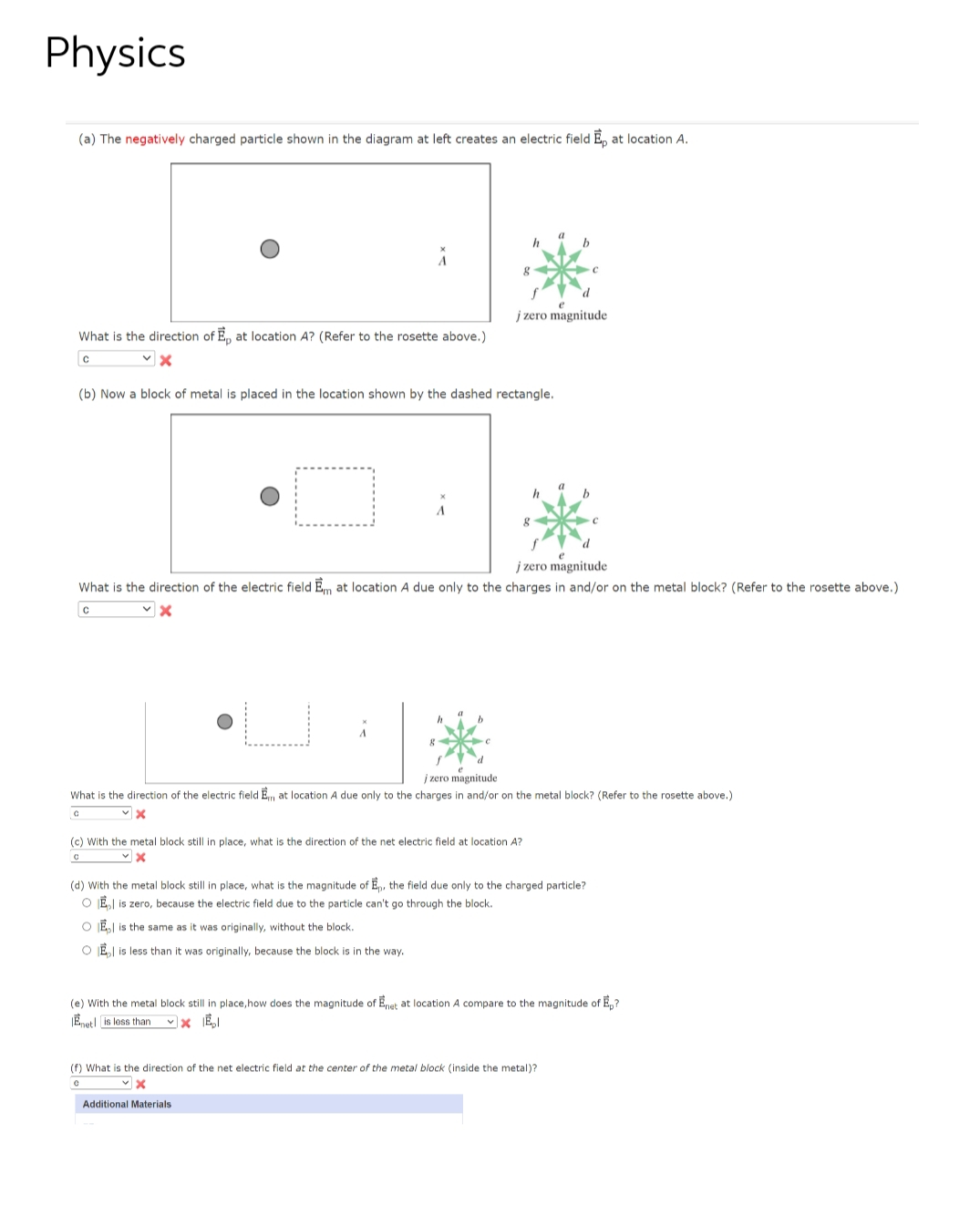(a) The negatively charged particle shown in the diagram at left creates an electric field Ep at location A. What is the direction of E, at location A? (Refer to the rosette above.) C ✓X 8 h (b) Now a block of metal is placed in the location shown by the dashed rectangle. a jzero magnitude b (c) With the metal block still in place, what is the direction of the net electric field at location A? 0 X b jzero magnitude What is the direction of the electric field Em at location A due only to the charges in and/or on the metal block? (Refer to the rosette above.) ✓x C 'd /zero magnitude What is the direction of the electric field E, at location A due only to the charges in and/or on the metal block? (Refer to the rosette above.) G x
(a) The negatively charged particle shown in the diagram at left creates an electric field Ep at location A. What is the direction of E, at location A? (Refer to the rosette above.) C ✓X 8 h (b) Now a block of metal is placed in the location shown by the dashed rectangle. a jzero magnitude b (c) With the metal block still in place, what is the direction of the net electric field at location A? 0 X b jzero magnitude What is the direction of the electric field Em at location A due only to the charges in and/or on the metal block? (Refer to the rosette above.) ✓x C 'd /zero magnitude What is the direction of the electric field E, at location A due only to the charges in and/or on the metal block? (Refer to the rosette above.) G x
Physics for Scientists and Engineers: Foundations and Connections
1st Edition
ISBN:9781133939146
Author:Katz, Debora M.
Publisher:Katz, Debora M.
Chapter25: Gauss’s Law
Section: Chapter Questions
Problem 34PQ: A very long line of charge with a linear charge density, , is parallel to another very long line of...
Related questions
Question
100%

Transcribed Image Text:Physics
(a) The negatively charged particle shown in the diagram at left creates an electric field E, at location A.
j zero magnitude
What is the direction of Ep at location A? (Refer to the rosette above.)
с
✓X
(b) Now a block of metal is placed in the location shown by the dashed rectangle.
d
j zero magnitude
What is the direction of the electric field Em at location A due only to the charges in and/or on the metal block? (Refer to the rosette above.)
C
✓X
j zero magnitude
What is the direction of the electric field Em at location A due only to the charges in and/or on the metal block? (Refer to the rosette above.)
C
✓X
(c) With the metal block still in place, what is the direction of the net electric field at location A?
C
✓x
b
(d) With the metal block still in place, what is the magnitude of En, the field due only to the charged particle?
OE is zero, because the electric field due to the particle can't go through the block.
O E is the same as it was originally, without the block.
OE is less than it was originally, because the block is in the way.
(e) With the metal block still in place, how does the magnitude of Enet at location compare to the magnitude of E?
Enet is less than ✓x E₂l
(f) What is the direction of the net electric field at the center of the metal block (inside the metal)?
e
✓x
Additional Materials
Expert Solution
This question has been solved!
Explore an expertly crafted, step-by-step solution for a thorough understanding of key concepts.
This is a popular solution!
Trending now
This is a popular solution!
Step by step
Solved in 3 steps with 2 images

Knowledge Booster
Learn more about
Need a deep-dive on the concept behind this application? Look no further. Learn more about this topic, physics and related others by exploring similar questions and additional content below.Recommended textbooks for you

Physics for Scientists and Engineers: Foundations…
Physics
ISBN:
9781133939146
Author:
Katz, Debora M.
Publisher:
Cengage Learning

Principles of Physics: A Calculus-Based Text
Physics
ISBN:
9781133104261
Author:
Raymond A. Serway, John W. Jewett
Publisher:
Cengage Learning

Physics for Scientists and Engineers: Foundations…
Physics
ISBN:
9781133939146
Author:
Katz, Debora M.
Publisher:
Cengage Learning

Principles of Physics: A Calculus-Based Text
Physics
ISBN:
9781133104261
Author:
Raymond A. Serway, John W. Jewett
Publisher:
Cengage Learning